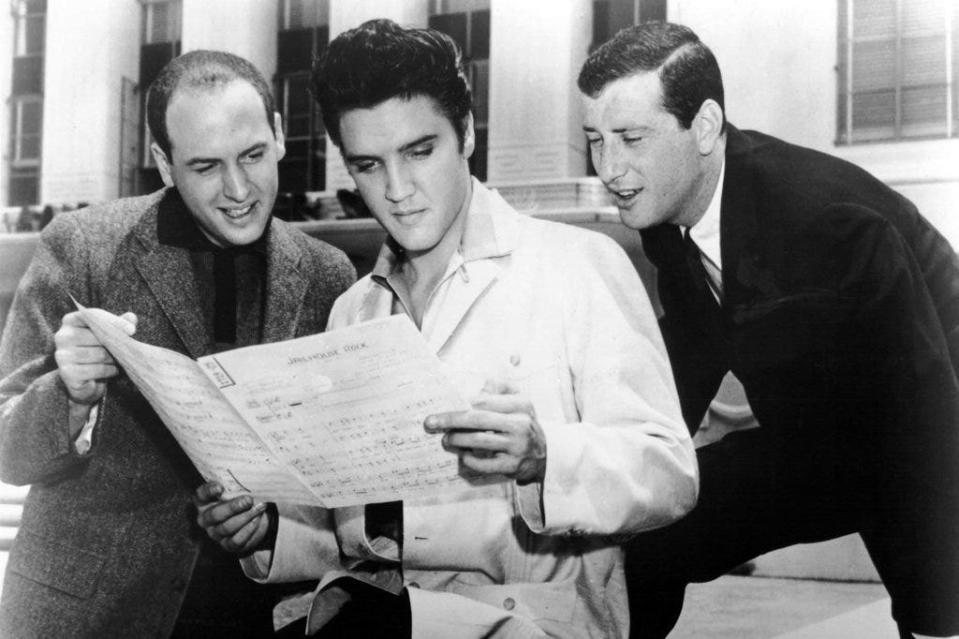Mike Stoller reflects on a pioneering pop legacy, including 'Hound Dog,' other hits
- Oops!Something went wrong.Please try again later.
The legendary story of Mike Stoller's seven-decade-long music career was almost swept away into the Atlantic Ocean.
Long before he became a Rock and Roll and Songwriting Hall of Famer with two songs in Grammy's Hall of Fame, Stoller found himself in a dangerous spot.
In 1956, the publisher, co-writer and arranger of 70 charting pop anthems alongside his collaborator, Jerry Leiber, almost died while returning from Italy after a Swedish passenger ship crashed into the Andrea Doria. Then 23, the composer, producer and songwriter had been returning from a three-month vacation aboard the luxury transatlantic ocean liner.

Stoller, now 90, appeared, for the first time in Nashville in a half-century, at the Country Music Hall of Fame and Museum last month. He was there to discuss a career spanning the integration of be-bop, boogie-woogie blues, jazz, pop standards and soul into rock n' roll. For Leiber and Stoller, the evolution involved work alongside foundational 20th-century American artists, including The Coasters, The Drifters, Ben E. King, Peggy Lee and Elvis Presley.
Before Stoller was 30, he'd created 27 top-10 singles with a dozen artists and became one of the first independent songwriters to be considered a "record producer."
The reason?
Rock n' roll emerged at the onset of the 1950s and many felt it was a "quickly passing, not too meaningful, phase of junk," recalled Stoller, while seated in the Country Music Hall of Fame and Museum's Ford Theater.
However, the quickly popular genre evolved into an earthquake representing youth culture entrenching itself in the global zeitgeist.
'Hound Dog'
Stoller was a recently-married, Los Angeles-based and still-working as a producer and songwriter when he went on the three-month European junket from April to July of 1956. It was paid for with a $5,000 royalty check linked to The Cheers' 1955-released single "Black Denim Trousers and Motorcycle Boots."

"I thought I'd never see that much money again at one time," Stoller joked during an interview with The Tennessean.
By the time Stoller safely arrived on shore in New York City after the wreck of the Andrea Doria, he was presented with more good news.
"Hound Dog" was a smash hit for Elvis Presley.
Initially, the song was a track he and Leiber had produced in 1952 -- as 19-year-olds requiring their parents to co-sign contracts -- for veteran African-American blues and gospel vocalist Willie Mae "Big Mama" Thornton.
A half-decade later, the song had become a gold-selling Chitlin Circuit touring staple of Black Southern venues.
Via Presley, the song topped the country, pop and R&B charts, eventually selling almost 10 million copies.

Stoller was not a fan.
"It just sounded terribly nervous, too fast, too white. But you know, after it sold seven or eight million records, it started to sound better," Stoller wrote in his and Leiber's 2009-released autobiography.
Stoller infuses pop with a world of influences
That's the thing about Stoller. His nuanced understanding of how to not haphazardly blur lines between culture, race, and sound allows his legacy to stand as an outlier in pop music's often-troubled history. Unlike the nation in which he lives, Stoller's work does not struggle with appreciating and understanding how empathy is achieved by honoring subtle cultural, racial and sonic differences.
"Hound Dog" takes its compositional cue from Southern Appalachian minstrel and vaudeville show "buck dancing," while The Coasters' 1957 debut single "Down In Mexico" combines doo-wop, flamenco and rockabilly stylings. The Drifters' 1959 hit "There Goes My Baby" samples the syncopated, Northeastern Brazilian baion dance rhythm and Peggy Lee's 1969 classic "Is That All There Is?" is derived from the orchestral, Broadway-ready, German-Italian cantastoria tradition.
Leiber and Stoller's work with Atlantic Records in the early 1960s with Ruth Brown was driven mainly by groovy, 12-bar blues shuffles, while LaVern Baker's songs, like "Saved," featured a more gospel-driven influence.
The influences, woven into Stoller's musical DNA because, can be traced to his childhood attendance of Camp Wo-Chi-Ca (also known as Workers Children's Camp). The co-ed, racially diverse and Communist Party-affiliated summer camp in Washington Township, New Jersey, existed from the 1930s-1950s.
While there, he observed a Black teenager practicing boogie-woogie piano in a barn that doubled as the camp's recreation hall.
Stoller laughed when recalling that, after watching him play, he tried to make his "fingers move like that."
His intrigue led him to study under influential, Harlem-based composer and pianist James P. Johnson.
Among Johnson's credits include birthing "The Charleston" dance craze, being Fats Waller's teacher, and inspiring Count Basie and Duke Ellington.
A continuous curiosity in pop's global meanderings weaves its way throughout Stoller's catalog.
"I always played things that I was already into at the time," Stoller said, citing a long tradition of loving Afro-Cuban sounds, be-bop, Brazilian music, Latin jazz, New Orleans jazz and salsa.
Stoller's use of orchestral strings for saxophone-like riffs and Italian tympani drums in The Drifters' "There Goes My Baby" was an influence for creators including Motown's songwriting and production team of Lamont Dozier and brothers Brian and Eddie Holland (The Supremes' "Baby Love," "Stop! In the Name of Love" and "You Keep Me Hangin' On").
Timeless pop stardards
Key to Leiber and Stoller's work is its tremendous flexibility. Songs written 70 years ago retain timeless relevance and multiple peaks in popularity.
When asked to break down this phenomenon, Stoller first cited the notion that he and Leiber were foremost music fans who admired artists as universally renowned as Ray Charles and as boutique-beloved as Charles Brown, Roy Hawkins and Jimmy Witherspoon. Couple this with Stoller's New York City roots involving seeing artists including Charlie Parker, Miles Davis and Thelonious Monk playing live. The earnestness of their art arrives as found, appreciated knowledge more than cool-at-the-moment hipster artifice.

Leiber's and Stoller's vision also keyed how The Coasters, one of the most important acts as storytellers-as-song stylists, created a generation-bridging catalog of hits.
"They were so talented individually that we could cast them as characters in songs that were more like cartoon narratives," said Stoller.
Songs like "Searchin'," "Young Blood" and "Yakety Yak" developed a doo-wop standard peerless enough to warrant The Coasters being the first group inducted into the Rock and Roll Hall of Fame in 1987.
Stoller's legacy
Most important with Mike Stoller is to highlight, at 90, the breadth of his legacy.
As songwriters, Stoller and Leiber also worked with Presley on his film actor era hits "Jailhouse Rock," "King Creole" and "Trouble."
Among the artists, producers and songwriters who count Stoller as an influence are Burt Bacharach and Hal David, Barry Mann and Cynthia Weil, Doc Pomus, Mort Shuman and Phil Spector -- among many he encountered in the 1960s.
A look deep into the production logs during his time as a label chief at Red Bird Records in 1964 reveals a credit for an up-and-coming pianist on The Shangri-La's top-five 1964 hit "Remember (Walking in the Sand)": a young Billy Joel.

Stoller gobsmacked but thankful when presented with nearly 150 years of music that his life touches,
"I've had this level of influence because I love listening to music, letting it settle in my consciousness and then letting the influences of artists and sounds that I admire and are inspired by influence listeners worldwide," he said.
This article originally appeared on Nashville Tennessean: Pop pioneer Mike Stoller on 'Hound Dog' and other timeless hits

